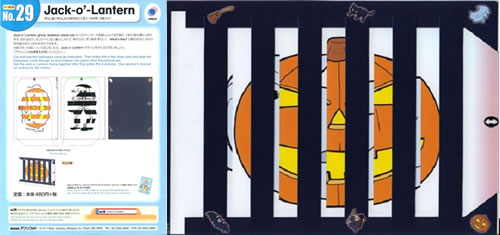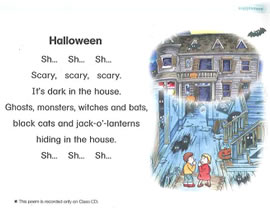What’s this??? … It’s a Jack-o’-lantern!


- vol.9 Halloween Activity
- Vol.8 Springboard Series & CD
- Vol. 7 Springboard Series Teaching Guides for ALL 16 Levels!
- Vol. 6 A Picture Dictionary with Appeal to ALL AGES!!
- Vol. 5 Springboard Series and Audio CDs
- Vol. 4 Big Book: Our Sweet Home
- Vol. 3 WELCOME to LW BLUE: Find the Ducks!
- Vol. 2 WELCOME to LW YELLOW: Find the Penguins!
- Vol. 1 Picture Book Workbooks: How to Use Them
vol.9 Halloween Activity
Halloween Items & Activities!
Simple 5-minute Activity for little children
Halloween Activity for children ”Find Your Partner”(Halloween version)
-
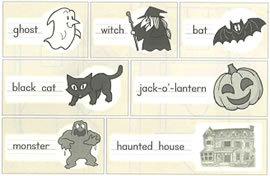
Prepare two cards of bat, ghost, jack-o’-lantern, black cat, monster, and haunted house.
- Shuffle and deal the cards, one card per student.
- Let your students find their partners by finding a student who has the same card.
- Once all the students have found their pair, sit down and read the Halloween poem together!
- Shh… Shh… Shh…
Scary, scary, scary
Dark in the house.
Ghosts, monsters, witches and bats,
Black cats and jack-o’lanterns Hiding in the house.
Sh… Shh… Shh…
I am a pumpkin, big and round.
Once upon a time, I grew on the ground.
Now I have a mouth, two eyes, and a nose.
What are they for, do you suppose?
With a candle inside, shining bright,
I’ll be a jack-o’-lantern on Halloween night.
→WELCOME to Learning World BLUE Student Book (p.36)
Halloween night (Elementary school level)
HALLOWEEN MAZE (Elementary school level)
Vocabulary list: cat, bat, pumpkin, ghost, monster, jack-o’-lantern, witch, broom
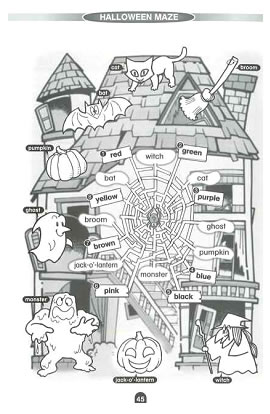 Learning World 1 WORKBOOK ”HALLOWEEN MAZE” (p.45)
Learning World 1 WORKBOOK ”HALLOWEEN MAZE” (p.45)
Vol.8 Springboard Series & CD
(Release date: July 2010)
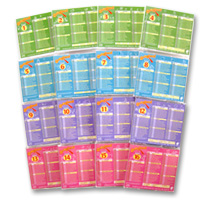
4 levels, 4 colors
800JPY + tax
- Level 1~4……Green
- Level 5~8……Blue
- Level 9~12……Purple
- Level 13~16..… Pink
♪ Audio Contents
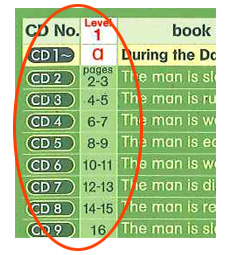
●Easy to find and repeat the audio – each track contains 2 pages!
●Audio with Sound Effects to enjoy the listening practice ♪
●Sound of a chime helps students when to turn the page over!
Listen to the audio CD, and practice reading with audio. The goal is to read at the same speed as the audio, as well as the pronunciation. Once your students achieve reading a story / 1 short book, mark the chart and let them choose the next book to read.
> Springboard Reading Chart

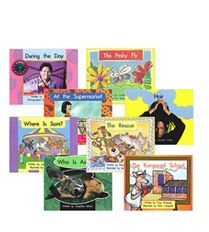
Springboard is an Australian-built program that is used in elementary schools. Level 1 is used in the first grade (5 years old, native). Short stories encourage children to finish reading a book.
Vol. 7 Springboard Series Teaching Guides for ALL 16 Levels!
| For teachers using the Springboard Reading series, you can download all of the Teaching Guides here for FREE! One file contains the Teaching Guides for all 8 books (a~h) in that level. Each Teaching Guide has detailed directions with reduced pages from the book and 2 worksheets! You can choose to just print out the worksheets! Worksheets are a fun way to check comprehension and work on phonics after completing a book! |
| LEVEL 1 Download PDF here |
|
|---|---|
| LEVEL 2 Download PDF here |
|
| LEVEL 3 Download PDF here |
|
| LEVEL 4 Download PDF here |
|
| LEVEL 5 Download PDF here |
|
| LEVEL 6 Download PDF here |
|
| LEVEL 7 Download PDF here |
|
| LEVEL 8 Download PDF here |
|
| LEVEL 9 Download PDF here |
|
| LEVEL 10 Download PDF here |
|
| LEVEL 11 Download PDF here |
|
| LEVEL 12 Download PDF here |
|
| LEVEL 13 Download PDF here |
|
| LEVEL 14 Download PDF here |
|
| LEVEL 15 Download PDF here |
|
| LEVEL 16 Download PDF here |
|
Vol. 6 A Picture Dictionary with Appeal to ALL AGES!!
“Do I really need a picture dictionary?”
“I’d like to use a picture dictionary, but I’m not sure how…”
Well, let us give you some ideas for how you can use AJ’s Picture Dictionary with your class!
Key Points When Choosing a Picture Dictionary
- It is essential that the pictures be fun, so that students want to spend time looking at them.
(You don’t want your picture dictionary to just “decorate” your shelves. - You should not buy a picture dictionary with fewer words for younger learners. You should buy a picture dictionary with at least 1,200 words, so that students can easily find the words they want.
(They should be able to use the same picture dictionary all the way up through upper elementary school.)
(From Matthew-sensei’s presentation at Nellie’s Seminar on 10/16/2013)
AJ’s PICTURE DICTIONARY has conversations, so you can use as a textbook!
The conversations can be found at the bottom of every page of AJ’s.
At ‘A Barbecue Party’, the key conversations are “Do you like~?” and “Would you like~?”. Students can use the words for different foods from the picture to complete and answer the questions.
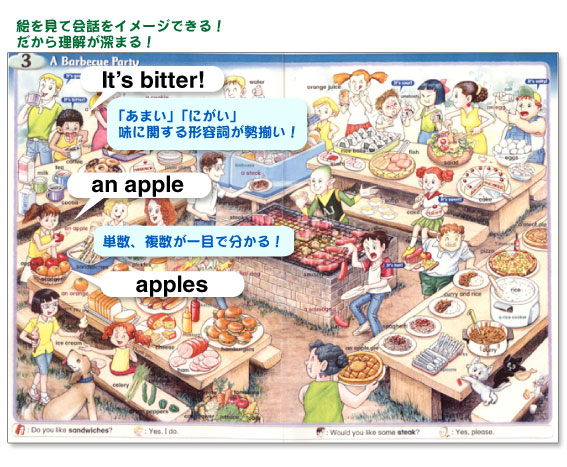 AJ’s PICTURE DICTIONARY pp.14-15
AJ’s PICTURE DICTIONARY pp.14-15
AJ’s Vocabulary CD goes with AJ’s Picture Dictionary. It has all of the 1300 words from the 25 scenes and the conversations between the main characters, found at the bottom of the page.
Audio tracks for “A Barbecue Party”:
>>♪ Basic Vocabulary (black)
>>♪ Supplementary Vocabulary (blue)
>>♪ Conversation Between Main Characters
Look very carefully at the pictures… there are lots of funny things going on!
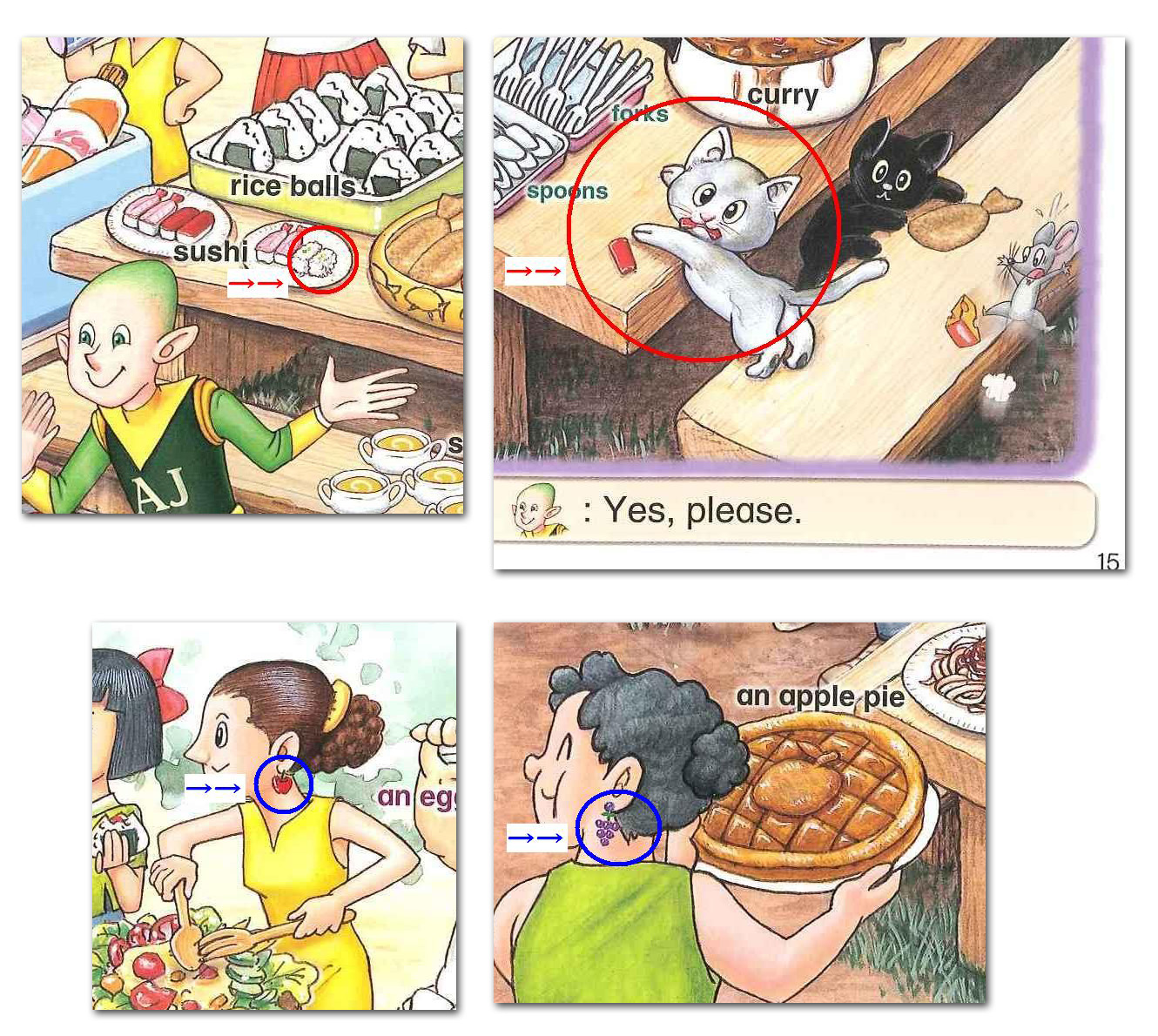
Look at the sushi…
No fish!?!
Uh, oh. The gray cat
is reaching for it…
What’s the gray cat eating?
(The tuna slice from the sushi on the table.)
Can you find all the
fruits in the picture?
Point to the fruit.
(on the table,
in the cake,
on some women’s earrings)
Main vocabulary is in black; secondary vocabulary is in blue! Easy to see and understand!
In “Wild Animals on Safari” the animals are in black, and lots of action verbs using the present continuous are introduced in blue.
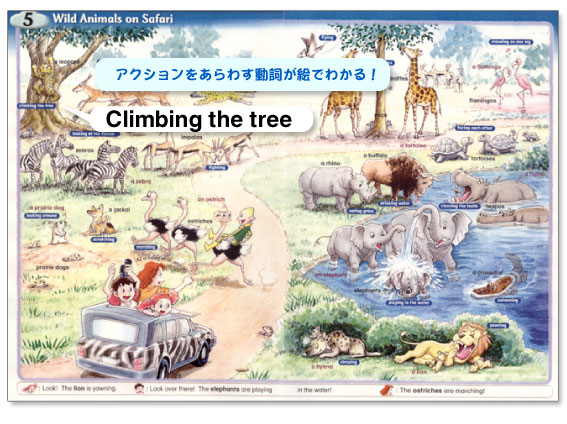
Look closely at the picture… there are also lots of chances to use language that is not on the page! ・How many mice are there? (Ten)
・Where is the pink heart? (Above the flamingoes) ・What does it mean? (Love)
“How do you say this in English?” ~Using “The Aquarium”~
When kids do not know a word in English, we teach them to say, “How do you say (カニ、イルカ、ナマコ) in English?” Based on the pictures, they understand what the word is. Sometimes, though, kids do not know the word in Japanese! Especially for the aquarium page, it would be realistic to also ask kids, “How do you say this in Japanese?” Get them to think about both languages!
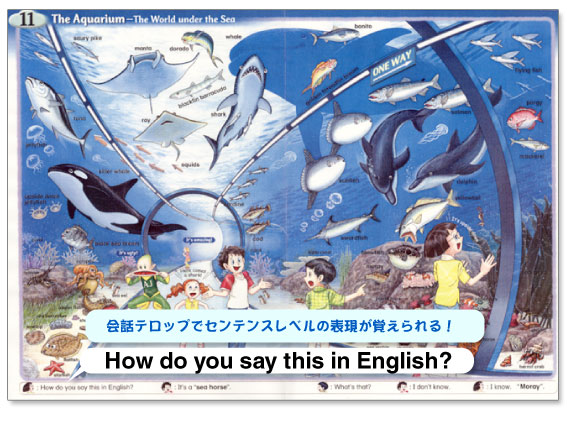
This is also a chance to elicit other language the students know. For example, AJ is looking at the angler fish.
This is especially good for upper level elementary school students to try and show what they know!
Dreams: learning occupations. Use “I want to be ~” to make a presentation!
Have students look at the right page…Who do you know on this page?
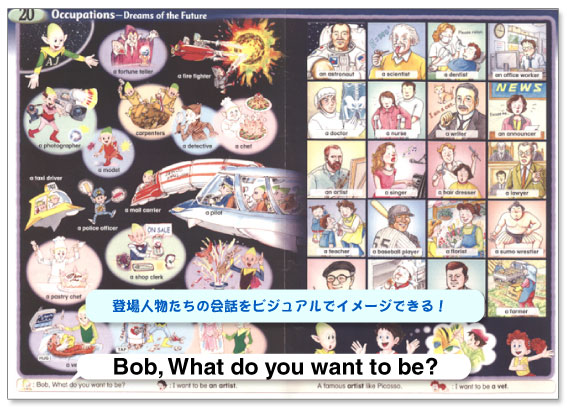
Teacher Notes for AJ’s Songs & Chants CD! (only available at events
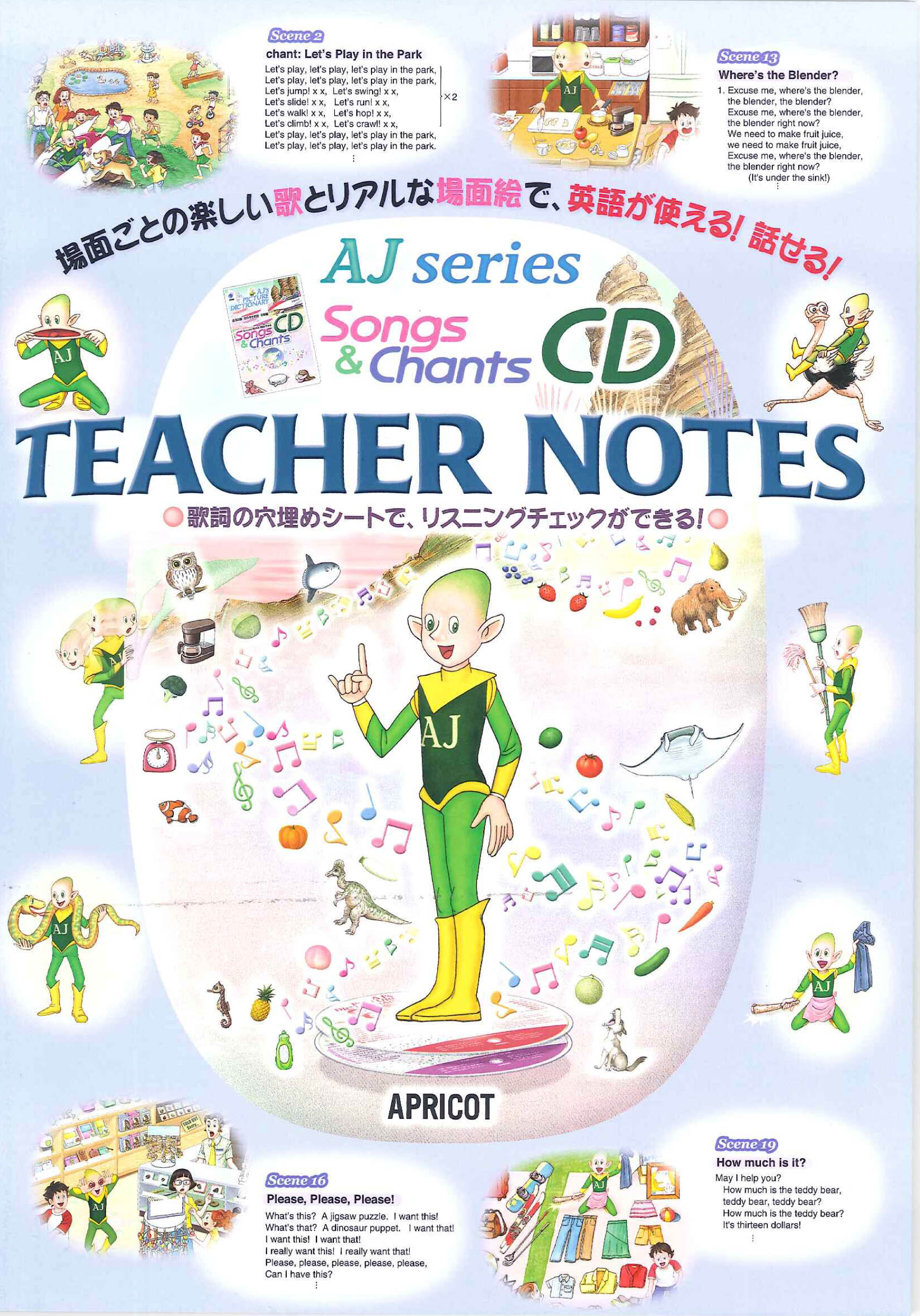
One song or chant per 1 photocopiable page (28 pages total)
・Fill in the missing lyrics for the songs and chants
・Put the phrases in the correct order
These are just a couple of the types of activities!
Recommended for teachers dealing with upper level elementary students who are getting shy about singing!
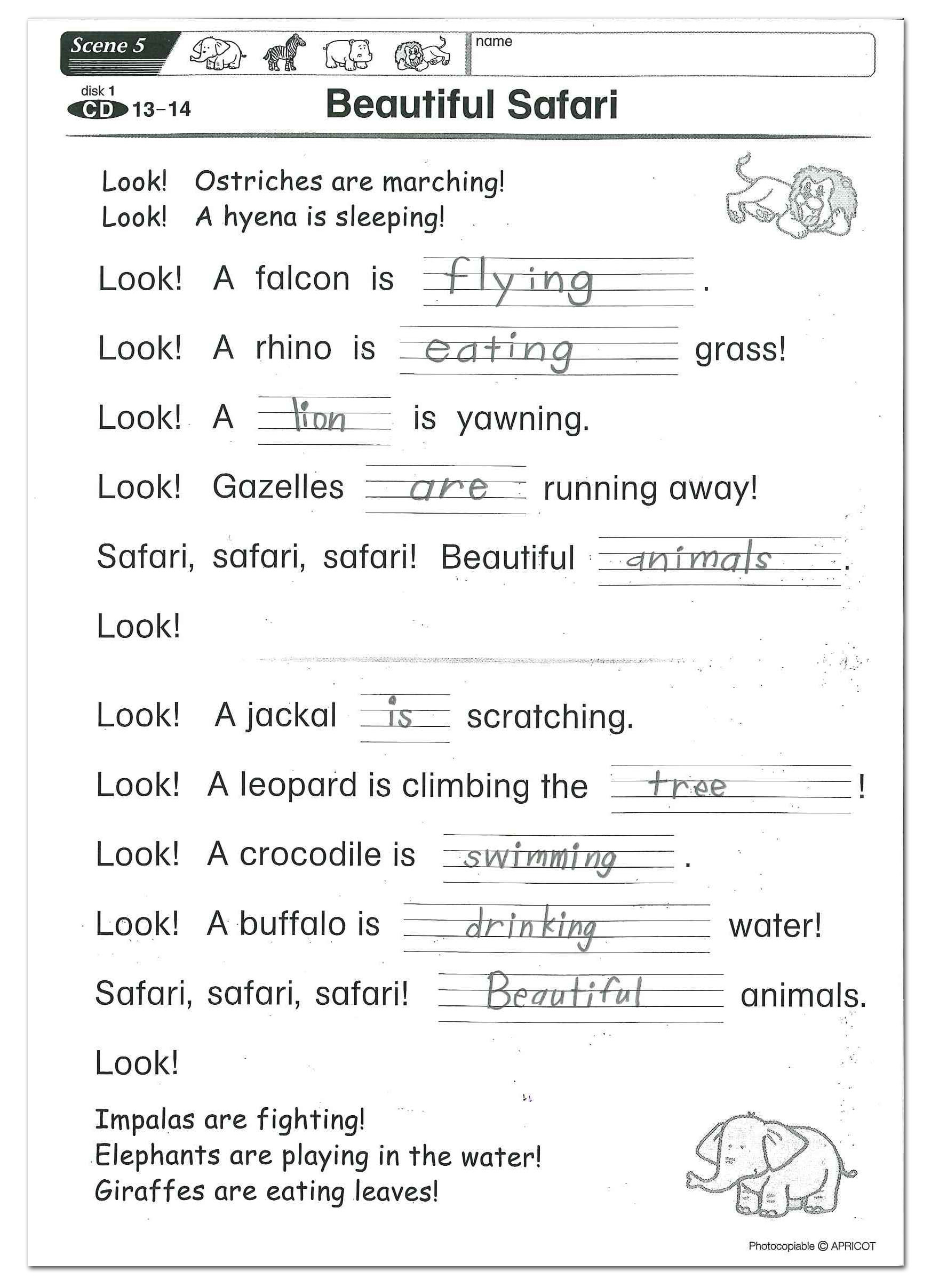
Introducing one of the photocopiable worksheets!
After studying the words for “Beautiful Safari”, have students listen to ♪ Beautiful Safari on AJ’s Songs & Chants CD and fill in the blanks.
They will have to listen a few times to catch all the words. While listening, those phrases will become naturally
established in students’ minds.
Vol. 5 Springboard Series and Audio CDs
Based on teachers’ requests, we started selling the audio CD in 2010.
You can use Springboard for in class storytime, or have students read the books for homework.

The 16 levels are divided into 4 colors (4 levels per color) for easy visibility.
- Level 1~4……Green
- Level 5~8……Blue
- Level 9~12……Purple
- Level 13~16……Pink
♪ Audio Contents:

● Every 2 pages is one track.
→ It’s easy to go back and listen to a certain page again. (Track numbers are on the CD insert.)
● Good sound effects ♪
→ Makes the audio more fun for the kids!
● Easy to understand when to turn the page!
→ Turn the page when the chime sounds.
- Have students listen to the CD while reading the book. They can pause the CD and repeat. They can also try to shadow the audio and say it at the same speed with the same intonation.
- You can have one CD and book for each student. They can do the reading for homework or during class time. You can set up a library for students to borrow the books and CDs. (Some schools have set up borrowing systems like a library, where they keep track of the student’s name, the date borrowed, and the due date for the materials. Some have also made library cards for their students.)
- During the next lesson, the students can read the story to the teacher and/or the entire class. If they read the story well, they can get the teacher’s signature for that book on a reading chart. The reading chart has three levels per page. Once students completely read through three levels, you can staple a new reading sheet in front of the completed one. Great for students to keep track of their own reading progress!
> Springboard Reading Chart is here!
How to use the level chart: Challenge students to read all of the books in each level. Write the name of the level they are working on at the top of that section. Each of the 8 books in a level is labeled with a letter from ‘a’ to ‘h’. So, for example, if a student reads book ‘d’ well, sign the square for book ‘d’. Once they have your signature in all eight squares, they are ready to move up to the next level! You can also use stickers or stamps or write the date in place of a signature, if you’d like.
This chart was first introduced by Matthew-sensei during APRICOT Plaza in 2009. Other teachers who started using the chart with their students gave the following feedback. “Using this chart really improved my students’ motivation! They are completely different!” Please try it out!


Springboard is the fantastic literacy program from Macmillan Education Australia, the PRIMARY PUBLISHER OF THE YEAR 3 years in a row. It is designed for children who are considered “at risk” for reading. In order to engage children who may not like to read, the content is varied and interesting, and the language starts very simple, gradually getting harder. A strength of the series is that it builds students’ reading confidence. Being able to read a book, and then complete an entire level makes students think, “Yay! I could read!” This feeling of accomplishment makes them want to keep reading.
Springboard is sold in level packs; each level pack has 8 books: 3 factual and 5 fiction.
Ways you can use Springboard:
▶ Every lesson I have 15 minutes of Reading Time. Students do not worry about words that they do not know, but keep practicing reading. They’ve been getting better and better as they get used to reading. Now, the 5th grade students can read one Level 15 book in 15 minutes! (N-sensei, Osaka)
▶ I use Springboard as a text. We check on words that the students do not know and read the books slowly. Springboard is a series of picture books, so when students take the books home, it is easy for their parents to understand what we are doing. Now students are studying Level 5, preparing for Step Test (Eiken) level 4. (K-sensei, Aichi)












